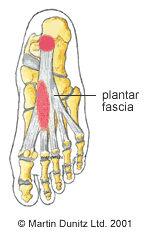| Common Signs & Symptoms | |||||
| Pain | Swelling | Stiffness | Weakness | Instability | Locking |
Plantar Fasciitis Explained – What is Policeman’s Heel?


Who is Affected By Plantar Fasciitis & What Causes It?
Injury to the Plantar Fascia usually occurs at the point where it attaches to the heel bone. Plantar Fasciitis is reasonably common in older individuals, where the movement in the joints of the foot has become restricted and strain on the Plantar Fascia is increased. It may also occur in individuals who do a lot of standing, walking or sporting activities, usually as a result of overuse. It tends to be more common in females and in people who are overweight. Individuals with low arches or who over-pronate (roll inwards) as they walk may also be more susceptible as the Plantar fascia is excessively loaded and strained.
Plantar Fasciitis Symptoms
Plantar Fasciitis produces foot pain over the inside of the heel and this usually radiates down the inside of the sole of the foot. This foot pain usually occurs with activity and is also typically present in the morning when taking the first steps of the day or when standing after prolonged sitting. The band tightens up with inactivity and then loosens as you walk and move around again.
How Do I Know If I Have Plantar Fasciitis?
Plantar Fasciitis can be diagnosed by a doctor or physiotherapist, if pain is present on touching the affected area, and/or on stretching the Plantar Fascia (by pulling the toes up). The diagnosis of Plantar Fasciitis can be confirmed on an Ultrasound scan, when the fascia has a thickened appearance. In a small number of cases of heel pain, that fails to respond to normal treatment, it may be necessary to get an x-ray to rule out other conditions such as a bony spur on the heel bone or a fracture of the heel bone.
Plantar Fasciitis Treatment
What you can do |
|
| Consult a sports injury expert | |
| Apply ice packs/cold therapy for pain relief | |
| Wear a night splint to stretch the Plantar Fascia | |
| Wear an Aircast AirHeel for quick & convenient effective treatment | |
| Tape the foot for effective treatment | |
| Support the inner arch with insoles | |
Plantar Fasciitis is inflammatory in nature and the key to successful treatment is to determine what is causing the inflammation and address this problem. In most sporting individuals the cause is overuse and the most important advice is to allow adequate rest, to take the strain off the Plantar Fascia and allow the affected tissues time to heal. The Aircast AirHeel can be very effective in the treatment of Plantar Fasciitis. The AirHeel reduces strain on the Plantar Fascia and applies pulsating compression with every step to help reduce swelling and discomfort, and enhance circulation.
Plantar Fasciitis Insoles Tackle Overpronation Issues
In some cases of Plantar Fasciitis there may be a problem with the biomechanics of the foot, contributing to the problem. The usual findings are a foot that ‘over pronates’, where the inner arch of the foot rolls over too much during walking and running. This can lead to tightness in the Achilles tendon and recent research has suggested that a tight Achilles tendon can increase strain on the Plantar Fascia. An insole that supports the inner arch of the foot can help to remedy this. Stiff joints around the foot and ankle can be treated using mobilisation, where the physiotherapist gently moves the joints manually to remove the stiffness and restore the normal range of movement. Conversely, there may be excessive ‘pronation’ and an insole that supports the inner arch of the foot may be helpful in alleviating strain on the Plantar Fascia. Browse sole care treatments for plantar fasciitis.
Conservative Massage Treatment
Conservative treatment, such as physiotherapy, aims to reduce local inflammation and address any biomechanical problems. The Plantar Fascia is continuous with the Gastrocnemius and Soleus muscles of the calf. Therefore relief may be provided by massage to these muscles and reducing the strain on the Plantar fascia. An effective self-treatment technique can ease out tension in the calf using the Massage Stick. Massage under the foot if pain allows can also help reduce tightness in the structures and ease symptoms. The Foot Roller is ideal. While the Plantar Fascia is still painful it may be treated with Ice Packs (never apply ice directly to the skin) and anti-inflammatory drugs prescribed by a doctor. Once the pain has subsided, stretching the Plantar Fascia (by pulling the toes towards the shin) is effective in encouraging the tissue to regain its normal alignment.
Can stretching cure plantar fasciitis?
Stretching the Plantar Fascia (by pulling the toes towards the shin) is effective in encouraging the tissue to regain its normal alignment. This helps the healing process and can relieve the symptoms of Plantar Fasciitis. Prolonged stretching of the Plantar Fascia can be achieved using a Night Splint which is worn during sleep. Research indicates that night splinting can significantly reduce Plantar Fasciitis symptoms in over 80% of cases – particularly pain on the first few steps after waking up each morning. The Night Splint is available to order online.
Does KT Tape work for plantar fasciitis?
Taping has been shown to be an effective treatment for Plantar Fasciitis. The tape supports the Plantar Fascia and removes some of the strain that can aggravate the condition. Shop KT tape online. In circumstances where a physiotherapist is not always available to apply the tape job, then the Air Heel is an easy to apply alternative that can effectively relieve the pain from Plantar Fasciitis. It works on the same principle as the taping technique to relieve strain on the Achilles tendon and Plantar Fascia.
Invasive Treatments: Cortisone Injections & Surgery
Plantar Fasciitis settles with conservative treatment in 95% of cases. However, in severe cases where heel pain is affecting normal walking then an injection with a mixture of corticosteroid and local anaesthetic can be helpful. Following this injection, the patient is required to rest for a few days, then normal activities can be resumed gradually.
How do you know if you need surgery for plantar fasciitis?
In persistent cases of Plantar Fasciitis, that fail to respond to 6 months of conservative treatment, then surgery can be considered. In the past, surgical techniques have included removal of bony spurs from the heel bone and release of the Plantar Fascia from the heel bone itself, but the results were inconsistent. These invasive surgeries often caused later problems such as nerve damage and changes to the mechanics of the foot.
Ultrasound Guided Needle Fasciotomy: An Alternative to Invasive Surgery
A modern treatment approach for Plantar Fasciitis is an ultrasound guided needle fasciotomy. This is a minimally invasive procedure where a needle is inserted into the Plantar Fascia and moved back and forwards to disrupt the fibrous tissue that proliferates as a result of the chronic inflammation. Because a needle is used instead of a scalpel, and because the whole procedure is observed using an ultrasound scanner, then there is far less danger of surgical complications. By disrupting the tight fibrous tissue the strain on the Plantar Fascia is relieved and healing can take place.
How to Prevent Plantar Fasciitis
What you can do
| Support the inner arch with insoles to limit excess pronation |
Inadequate footwear is often implicated in Plantar Fasciitis. Shoes should provide adequate support for the foot. Unsuitable footwear can increase strain of the Plantar Fascia and lead to the development of inflammation
Insoles that support the arch on the inner side of the foot can be helpful for limiting excessive pronation and relieving stress on the Plantar Fascia and Achilles tendon.
Self massage to the Calf muscles (Gastrocnemius and Soleus) using a Massage Stick, strengthening exercises for the arch and stretching are all effective ways of easing the symptoms of Plantar Fasciitis at home.


